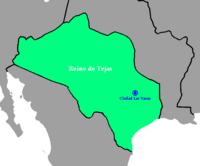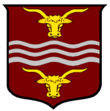Ciudad Las Vacas
| |||||
| City nickname: "CITY NICKNAME" | |||||
 Location of Ciudad Las Vacas in Tejas | |||||
| Province | Guichita (?) | ||||
| Alcalde | Jose-Ramón Agamano | ||||
| Area |
TOTAL AREA km² | ||||
| Population - Total (as of 2008) |
Vacanos 238,000 | ||||
| Time zone - summer (DST) |
TIMEZONE (UTCUTC OFFSET) TIMEZONE DST (UTCUTC OFFSET DST) | ||||
Ciudad Las Vacas is a smaller city in eastern Tejas. Its full Castillian name is Ciudad Las Vacas de San Miguel, which derives from an old local ranch close to the old Mision San Miguel. The ranch became the centre of an important local livestock market, and the livestock market gave rise to the city.
Location
Ciudad Las Vacas is located in eastern Tejas on the Trinidad river, approximately where the city of Fort Worth stands *here*.
Administration
History
Economy
Ciudad Las Vacas is located very close to several large natural gas fields, and these form the basis of much of its modern economy, together with the helium which can be extracted from the gas. The city is historically an important livestock trading centre, and there are also several large ranches in the area. Livestock farming, particularly cattle, together with its associated meat processing, is another large employer in the area, and many Vacanos are also employed in serving the local Tejano military base which lies to the west of the city.
Culture
The three major components of the Vacano local economy (livestock, natural gas/helium and the military) each bring a different aspect to the city's culture.
Older Vacanos (ie those who have lived in the area for a while) are most likely to be involved in the livestock and meat trades; they are traditional, firmly Catholic, hardworking, a little suspicious of strangers and firmly convinced that Ciudad Las Vacas is still the best city in Tejas, but it used to be a whole lot better (and it ought to have remained so!).
"New" Vacanos are those who have come to the city in the urban growth associated with the gas industry. They are proud of their city's ranching and livestock-trading past, and will consciously dress like a vaquero. This annoys the real ranchers and old Vacanos, as they feel that the newcomers have no right to pretend to be something they are not. Conversely, a lot of the new Vacanos see their older compadres as living in a fantasy of the past, and comments such as "It's 2009, not 1909" are not unknown.
The military personnel are more or less the social "glue" that holds everything together. Many of them are, to an extent, newcomers too, but they are respected and honoured by the old Vacanos, who were raised to hold the Tejano military and its serving personnel next to the Church in their esteem. The new Vacanos also tend to like the military personnel, because they spend money. For their part, the military personnel get on well with the oldtimers and the newcomers; the military is a highly traditional body, which gives them commonality with the old Vacanos, and they recognise the source of a critical military technology (airship-grade helium) in the newcomers' gas wells.
Another defining aspect of Ciudad Las Vacas, though not a prominent one, is the inter-city rivalry between it and its smaller eastern neighbour De Soto. As with most rivalries of this type, it is more keenly felt by the inhabitants of the smaller city; in this case, De Soto. This rivalry mostly exhibits itself in sports competitions: the fútbol rivalry between Los Perros of Ciudad Las Vacas and Los Gatos of De Soto is particularly intense, and crowd control officers at such games typically don riot gear, especially if it is a competition match.

